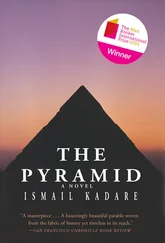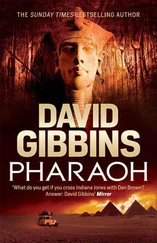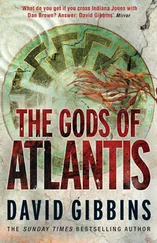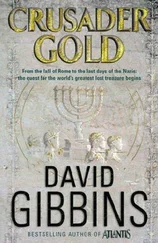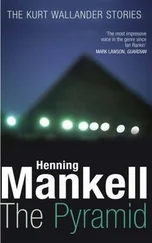“Give us a rundown, Maurice,” Costas said.
“Okay. You’ve got the three pyramids, Khufu, Khafre, Menkaure, largest to smallest, north to south. They’re on the edge of a plateau called the Mokkatam Formation, a limestone ridge that rises at this point about fifty meters above the modern suburb. To the east of the plateau is the ancient floodplain of the Nile, to the west the open desert. The limestone is easily quarried and easily tunnelled. The plateau to the east of the Pyramid of Menkaure is completely free of ancient structures, leaving the raised plateau in front bare over almost a square kilometer until you drop down into the floodplain.”
“You mean where we would have been looking when we were suspended beneath the pyramid, facing east?” Costas asked. “Where we were looking down the blocked-up tunnel?”
Hieberemeyer nodded. “First, let’s look at what we can see aboveground. This image shows the plateau as it might have looked during the New Kingdom, about the time of Akhenaten, over a thousand years after the pyramids were built. Originally each pyramid would have been fronted by a mortuary temple, and then a further temple — really a kind of entrance portico — on the floodplain below. The two were joined by a causeway. But by the time of the New Kingdom, the mortuary complexes for the Pyramids of Menkaure and Khafre had been removed, and everything was focused on the structures associated with the Great Pyramid. By then, of course, the use of these structures as mortuary temples, to prepare the bodies of the pharaohs for the afterlife, was ancient history, and I mean really ancient history. People tend to think of Pharaonic Egypt as a continuum where everything can be lumped together, whereas in fact we’re dealing with a time span between the construction of the pyramids and the time of Akhenaten — similar to that between, say, the end of the Roman period and the present day. In such a huge expanse of time, we should expect monuments to change in meaning and function.”
Jack nodded. “So what began as communities of priests perpetuating the memory of the three individual pharaohs — Khufu, Khafre, and Menkaure — becomes a unified cult of the ancient pharaohs, centering on the one complex associated with the Great Pyramid. The other temples become redundant.”
“And more than that,” Hiebemeyer enthused, “the entire cult could have become redundant.” He paused, standing back. “What is it that fascinates us most about the pyramids? It’s not so much the dead pharaohs, but the engineering marvel and the geometry of the alignments, the relationships in particular to the sun. Egyptians of the New Kingdom would have been as awestruck by these ancient monuments as we are today, and would have been well aware of the celestial alignments. They would have celebrated them. It’s my belief that the cult of the pharaohs would have been largely subsumed by a cult of the Sun, of Ra and the other sun gods, a transition that could have taken place already by the beginning of the New Kingdom.”
“And that brings us to Akhenaten,” Costas murmured. “And to how it was that plaques showing the Aten sun symbol could have been placed inside the burial chamber of Menkaure, something that would have been impossible while his cult was still alive.”
Hiebermeyer nodded, and pointed at the screen. “Let’s look at these structures in front of the Great Pyramid first. This is what was revealed during the sewer construction. What was officially revealed, that is. First, a mass of mud-brick buildings that was undoubtedly part of the town that sprang up to house the workers and then the priests who maintained the cult. Second, the remains of a huge mud-brick wall, the so-called palace. Third, the massive basalt revetment of the man-made harbor abutting the valley temple, joined to the Nile by canals wide enough to float barges with stone blocks up to the harbor and later for the ceremonial final boat journey of the dead pharaoh from the Nile to the mortuary temple.”
Costas pointed at a sinuous channel shown to the east of the harbor. “You mean here?”
“That’s the Bar el-Libeini, the projected line of a channel of the Nile in Old Kingdom times. Since then it’s silted up, and the main channel of the river has progressively migrated east, except in a few places where it has remained in more or less its ancient position. The man-made canals have also been lost, but they would have been huge engineering feats in their own right.”
“What all this shows,” Jack said thoughtfully, “is that the construction of some kind of passage between the Nile and the Giza plateau, an underground passage, would have been perfectly feasible, and our idea that those radiating lines on the Aten symbol might map out its course is within the realm of possibility.”
“More than that, Jack. It’s a dead certainty.”
“Go on.”
Hiebermeyer took a deep breath, steadying his excitement. “I’ve listed the official discoveries. Well, now for the unofficial ones.” He reached under the computer table, felt around for a moment, and then pulled out a book-sized slab of highly polished granite, the end of a hieroglyphic cartouche deeply cut in its surface. He placed it carefully on the table beside him and then swept his hand across the surface. “This has been my guilty secret for all these years. I’ve been waiting for the right time to reveal it, and this is it. I’ve got nothing to lose.”
Costas peered at it. “There’s that bird, the Egyptian buzzard. And the mouth, the face, and the half sun. The rest I don’t recognize.”
Hiebemeyer’s voice was taut with excitement, and his hand was trembling as he traced out the hieroglyphs. “I found this that night in the trench beside the huge mud-brick wall. This is why I said the so-called palace; it’s because it wasn’t a palace. There are three certain words here. One is secrets . Another is writing . Another is storeroom , or repository . The only other person I’ve shown this to is Aysha, who happens to be my best hieroglyphics expert. She’s certain it means storeroom of written secrets .”
There was a stunned silence. “My God,” Jack whispered. “A library .”
Hiebermeyer stared at Jack, his face flushed. “I always objected to the word palace . A closer approximation would be monastery, a place where priests lived and worked. And just like medieval monasteries, the priestly colleges of ancient Egypt would have been repositories of knowledge. Do you remember the Temple of Sais in the Nile Delta, where Solon the Greek heard the Atlantis story? By that stage, half a millennium after Akhenaten, the old knowledge had become fragmented, parcelled among many temples, jealously guarded by the priests and passed down only by word of mouth. The first Macedonian king of Egypt, Ptolemy I, tried to rectify that with his establishment of the great library at Alexandria, though by then much of the old knowledge had died after the closure of the last of the ancient temples. But I believe that he was inspired by a memory of a great centralized repository, a great library, that had existed far back in the glory days of the pharaohs, in the New Kingdom at the time of Akhenaten and his son, Tutankhamun.”
“And where better than at Giza,” Jack murmured. “The great center for the worship of the sun god during the New Kingdom, and before that of the earliest pharaohs. A place of continuous occupation by a priestly caste for over two thousand years, priests who could safeguard a repository of knowledge through the centuries.”
“And if this was a library, it could have been the earliest library on this scale anywhere,” Hiebermeyer exclaimed. “That mud-brick wall dates back to the Old Kingdom, to soon after the construction of the Great Pyramid, about 2500 BC. That’s over a thousand years before the heyday of the New Kingdom, before Akhenaten. Imagine what such a repository might have contained: all the knowledge passed down from Egyptian prehistory, from the time of the first hieroglyphic texts of the previous millennium as well as the oldest writings of Mesopotamia. And we’re not just talking about funerary texts, sacred mantras, Books of the Dead, and all the familiar religious tracts, but about material that predates and transcends all that: the earliest sagas and histories, accounts of exploration and discovery, lost medicinal knowledge. Ptolemy’s library at Alexandria would have been only a pale shadow of that.”
Читать дальше


